It's been quite a while since I've managed to do any proper cooking at Oxford, so I decided to usher in the end of term in a decidedly celebratory way.
I am generally not a fan of white meat, and I would prefer beef to chicken any day. However, after I once had the most fabulous stewed rabbit in Provence, rabbit meat has become one of my favoured meats.
Now, a lot of people get very squeamish around rabbits, and refuse to countenance the thought of eating them. Mainly because rabbits are cute and fluffy, so people can't bring themselves to eat them. I have no such problem, since when it comes to food, I'm an animal egalitarian. However, if you are in the least bit uncomfortable about rabbits, be warned that a skinned rabbit from your local butcher's is a very ugly thing, looking like some deranged chupacabra.
So I decided to cook a rabbit stew, after discovering that rabbits are much healthier than poultry (less fat and cholestrol), and not that expensive (one rabbit costs GBP 3.50 from Oxford's covered market). Being new to rabbit cookery, I had to look around for a recipe, but as with most stews, the basic principles are the same, and you could even use a coq au vin recipe to cook a lapin au vin. In the end though, I settled on a modified version of this one.
Ingredients (Serves 2 - 3)
1 rabbit, jointed
1 tin (500g) peeled tomatoes
4 cloves garlic, minced
1 carrot, chopped
2 stalks celery, chopped
1 large onion, chopped
5 sage leaves
5 sprigs thyme
3 sprig rosemary
300 ml dry white wine
300 ml chicken stock
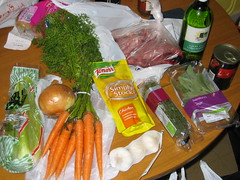
Notes on ingredients: Ask your butcher to joint the rabbit for you. Save the heart and liver for making stock or enriching your sauce, or be lazy and throw them away. Rabbit forelegs cook faster than the hind legs and saddle, so you can choose to save them for stock or throw them in to cook in half the time. Depending on the size of your pot, you may need more liquids than the quantities specified.
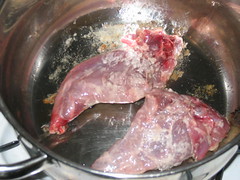
On medium-high heat, heat some olive oil in a large pot and sauté the rabbit joints till they're golden. You can dredge them through flour (as in the photo) first, but it's not strictly necessary.
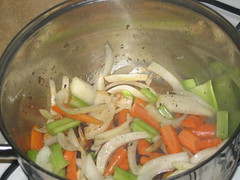
Once your rabbit joints are browned, remove them. In the same oil (add more if you've run low) fry the garlic till fragrant and golden, and then sauté the vegetables till the onions soften.

Add half the wine and stock to stop the vegetables from cooking any more.
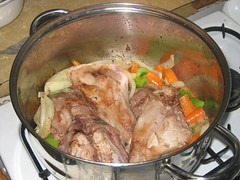
Return the rabbit joints to the pot. Try not to let them rest on the vegetables, or you risk burning them at the bottom.
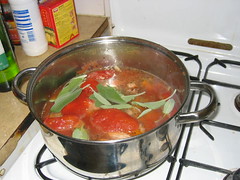
Add the canned tomatoes and their juice, as well as the rest of the wine and stock to just about cover the rabbit. Throw in the sage, thyme and rosemary at this point as well.
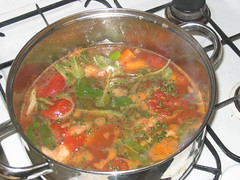
Bring the contents of the pot to boil, then turn the heat down to a gentle simmer. The more observant among you will probably have noticed the similarities between this recipe and other slow-cooked recipes, like osso bucco.
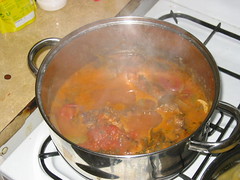
Simmer the stew, covered, for an hour or so, or until the rabbit meat is tender. There appears to be some considerable disagreement as to how long rabbit should be cooked before it's tender. Many recipes say 30-45 minutes, but I've seen some going up to 2 hours. Cooking time depends on how generously you interpret "simmer", so the best bet would be to check the rabbit after half an hour, and consequently every fifteen minutes or so until it's just right.
Bear in mind though, that the forelegs take a much shorter time to cook than the rest of the rabbit, so either remove them earlier, or add them to the stew later.
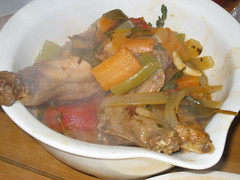
Serve the stew with any filling carbohydrate, like potatoes, noodles or rice. A real treat on a dark and shivering English night, or equally appropriate during the warmer Easter period.
Technorati Tags: Recipes, Rabbit Stew



No comments:
Post a Comment